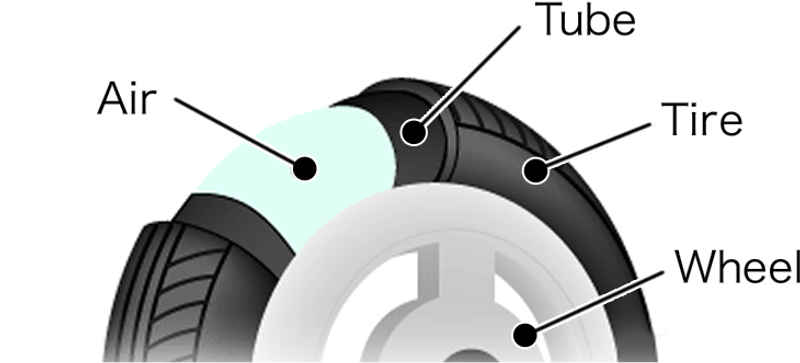Pneumatics is a branch of engineering that makes use of gas or pressurised air. Pneumatic tyres hence are tyres that make use of pressurised air or other gases for inflation.
A pneumatic tyre consists of an airtight inner core which is filled with pressurised air/gas. This inner core could be tubed or tubeless depending on the type of the tyre. A tread and belt system cover this inner core with the former providing the external cover that makes contact with the road.
Who Invented The Pneumatic Tyre
Robert William Thomson was the first person to invent the first vulcanized rubber pneumatic tyre. He did patent this invention of his but unfortunately, the whole process of manufacturing his tyres was way too costly to be commercially viable.
This drawback was remedied by John Boyd Dunlop (1840–1921) who was a Scottish veterinarian and the recognized inventor of the first “practical” pneumatic tyre. Dunlop was the inventor of the first practical and commercially viable pneumatic tyre, although these tyres were not for automobiles but cycles.
An important parameter for pneumatic tyres is that the pressure inside the tyre is always kept greater than the atmospheric pressure in order to keep it inflated. The pressurised air inside along with the soft rubber give the tyre resistance as well as the flexibility to absorb shock.
Pros And Cons of Pneumatic tyres
Pros
- Deform easily
They can deform very easily as rubber is flexible and the air being compressible allows the tyre to deform around obstacles that come in the way of the tyres.
- Good shock absorbers
It also has a good ability to absorb shocks both from the load it's carrying as well as the obstacles on the road.
- Great for off-road terrains as well as on-road
These wheels lend themselves well to applications that require both off-road and on-road operation as they are capable of being both smooth for on-road purposes as well as shock-absorbent for the unevenness of off-road terrain.
- Offer good comfort and quiet operation
Pneumatic tyres are also quiet in use because of the soft rubber tread and shock absorbing ability. Loud noises are reduced which improves drivability and comfort.
Also See: Who Invented The Tyre?
Cons
- Continuous monitoring and refilling required
A major disadvantage of pneumatic tyres is that there is a continuous need for monitoring and refilling them. These tyres are prone to punctures and can often require repairs and regular inspections.
- Dangerous blowouts
Since a pneumatic tyre is inflated full of air, any major puncture can cause a major blowout of the tyre. A blowout is a phenomenon where the tyre loses air pressure rapidly. If a blowout happens at a very high speed, it could have catastrophic consequences since the sudden loss of pressure in the tyre can destabilise the car.
- Not suitable for military applications
Military vehicles are frequently exposed to conditions like gunfire or explosions, shrapnel from which can easily puncture pneumatic tyres. Punctured tyres could potentially be disastrous for such vehicles if they're under fire as their ability to move will get completely compromised.
- Tyre performance variability
Another issue that comes up with pneumatic tyres is how air pressure can define the tyre's performance. Lower tyre pressure can flatten the tyres and lead to increased traction due to more contact area. However, more traction will also lead to a loss in fuel efficiency since rolling resistance will go up. Reduced air pressure also leads to more sidewall flexion which leads to poor handling. Hence, tyre performance is never constant with pneumatic tyres. It always depends on how well regulated the tyre pressure is which takes a little effort.
Due to these disadvantages of pneumatic tyres, non-pneumatic/airless tyres are being pitched as replacements and many companies have already come out with prototypes and models of their non-pneumatic/airless tyres.
These airless tyres are essentially made up of polymer spokes (seen in image above) rather than an air-filled interior that enables them to absorb shocks. These polymer spokes are connected to the hub as well as an outer ring which forms the rubber tread.
Airless tyres are far more consistent with respect to performance, are immune to blowouts and punctures and need very little maintenance.
Image Credits: goauto.ca

